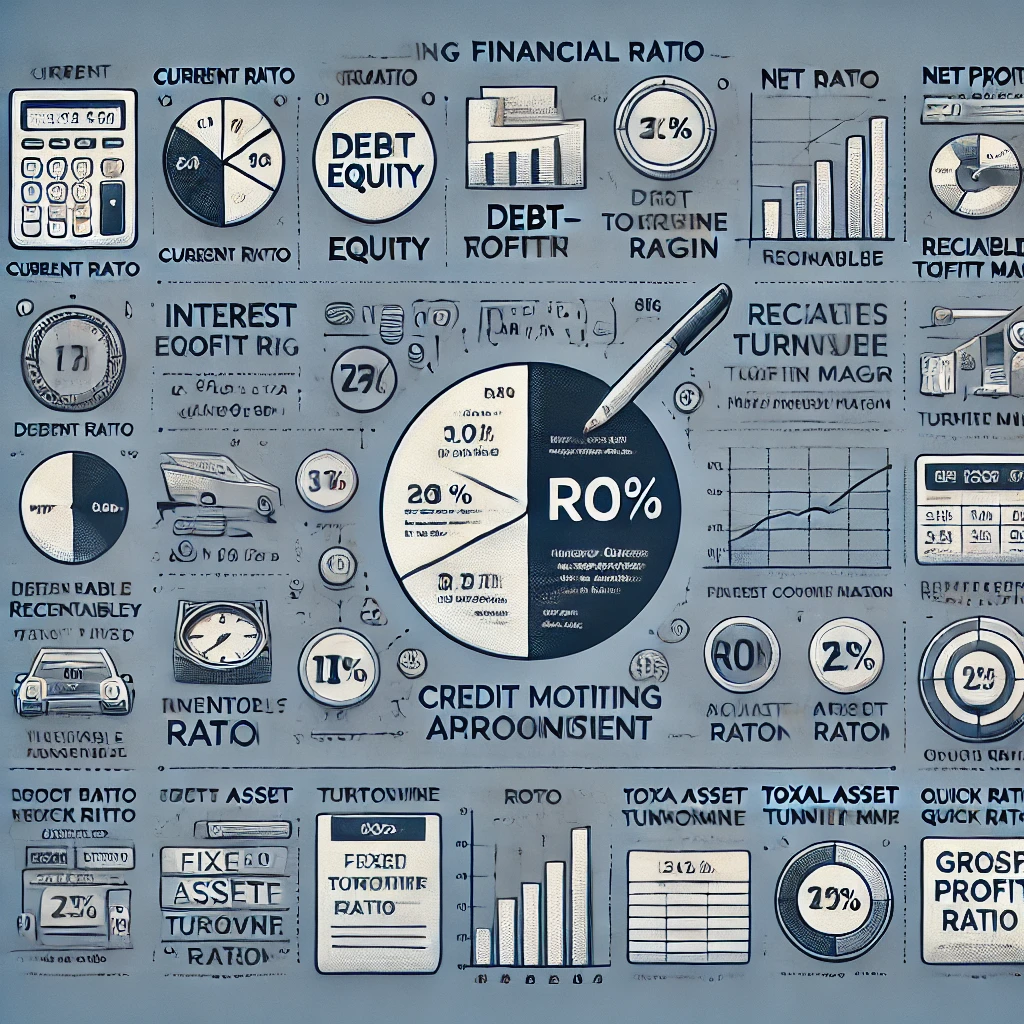Drafting a Credit Monitoring Arrangement (CMA) report is crucial for businesses seeking loans or credit facilities from financial institutions. The CMA data helps banks and lenders assess the financial health and creditworthiness of a business. One of the most critical components of a well-structured CMA report is the calculation of financial ratios. These ratios provide insight into various aspects of a company’s financial performance, liquidity, profitability, and leverage.
In this comprehensive guide, we will explore the 12 key financial ratios that play a pivotal role in drafting CMA data.

1. Current Ratio
The current ratio is one of the most commonly used liquidity ratios. It helps lenders evaluate a company’s ability to cover its short-term liabilities with its short-term assets.
Formula:Current Ratio=Current AssetsCurrent Liabilities\text{Current Ratio} = \frac{\text{Current Assets}}{\text{Current Liabilities}}Current Ratio=Current LiabilitiesCurrent Assets
Ideal Value: A current ratio of 2:1 is considered ideal in most industries. However, this can vary depending on the type of business.
2. Debt-Equity Ratio
This ratio is a measure of a company’s financial leverage. It indicates the proportion of debt and equity a company uses to finance its operations and assets.
Formula:Debt-Equity Ratio=Total DebtShareholders’ Equity\text{Debt-Equity Ratio} = \frac{\text{Total Debt}}{\text{Shareholders’ Equity}}Debt-Equity Ratio=Shareholders’ EquityTotal Debt
Ideal Value: A debt-equity ratio of 1:1 is often considered balanced. Higher ratios may indicate higher financial risk.
3. Operating Profit Margin
The operating profit margin ratio measures a company’s efficiency in controlling its operating expenses. It shows the percentage of profit a company makes from its operations before deducting interest and taxes.
Formula:Operating Profit Margin=Operating ProfitNet Sales×100\text{Operating Profit Margin} = \frac{\text{Operating Profit}}{\text{Net Sales}} \times 100Operating Profit Margin=Net SalesOperating Profit×100
Ideal Value: An operating profit margin above industry standards indicates efficient management of operational expenses.
4. Net Profit Margin
Net profit margin represents the percentage of revenue that remains as profit after all expenses, taxes, and interest have been deducted.
Formula:Net Profit Margin=Net ProfitNet Sales×100\text{Net Profit Margin} = \frac{\text{Net Profit}}{\text{Net Sales}} \times 100Net Profit Margin=Net SalesNet Profit×100
Ideal Value: Higher net profit margins indicate better profitability. Companies should aim for margins that exceed the industry average.
5. Interest Coverage Ratio
The interest coverage ratio is crucial for assessing a company’s ability to meet its interest obligations. It indicates how many times a company can pay its interest expenses from its operating profits.
Formula:Interest Coverage Ratio=EBIT (Earnings Before Interest and Taxes)Interest Expense\text{Interest Coverage Ratio} = \frac{\text{EBIT (Earnings Before Interest and Taxes)}}{\text{Interest Expense}}Interest Coverage Ratio=Interest ExpenseEBIT (Earnings Before Interest and Taxes)
Ideal Value: A ratio of 3 or higher is considered good, as it indicates that the company can comfortably meet its interest obligations.
6. Inventory Turnover Ratio
This ratio measures how efficiently a company manages its inventory by comparing the cost of goods sold with average inventory levels.
Formula:Inventory Turnover Ratio=Cost of Goods SoldAverage Inventory\text{Inventory Turnover Ratio} = \frac{\text{Cost of Goods Sold}}{\text{Average Inventory}}Inventory Turnover Ratio=Average InventoryCost of Goods Sold
Ideal Value: A high inventory turnover ratio signifies efficient inventory management, though too high a value may indicate stockouts or insufficient inventory levels.
7. Receivables Turnover Ratio
This ratio shows how efficiently a company collects revenue from its customers by comparing net credit sales to average accounts receivable.
Formula:Receivables Turnover Ratio=Net Credit SalesAverage Accounts Receivable\text{Receivables Turnover Ratio} = \frac{\text{Net Credit Sales}}{\text{Average Accounts Receivable}}Receivables Turnover Ratio=Average Accounts ReceivableNet Credit Sales
Ideal Value: A higher receivables turnover ratio indicates that the company is efficient in collecting debts from customers.
8. Fixed Asset Turnover Ratio
This ratio measures how efficiently a company uses its fixed assets to generate revenue.
Formula:Fixed Asset Turnover Ratio=Net SalesNet Fixed Assets\text{Fixed Asset Turnover Ratio} = \frac{\text{Net Sales}}{\text{Net Fixed Assets}}Fixed Asset Turnover Ratio=Net Fixed AssetsNet Sales
Ideal Value: A high ratio implies efficient use of fixed assets in generating sales.
9. Return on Investment (ROI)
ROI measures the return on the overall investment in the business, showing how effectively a company uses its capital to generate profits.
Formula:Return on Investment=Net ProfitTotal Investment×100\text{Return on Investment} = \frac{\text{Net Profit}}{\text{Total Investment}} \times 100Return on Investment=Total InvestmentNet Profit×100
Ideal Value: A higher ROI indicates a more profitable and efficiently managed business.
10. Gross Profit Margin
Gross profit margin is the percentage of revenue that exceeds the cost of goods sold (COGS). It reflects the efficiency of production and pricing.
Formula:Gross Profit Margin=Gross ProfitNet Sales×100\text{Gross Profit Margin} = \frac{\text{Gross Profit}}{\text{Net Sales}} \times 100Gross Profit Margin=Net SalesGross Profit×100
Ideal Value: The higher the gross profit margin, the better. It indicates the company is efficiently managing its production costs and pricing its goods or services appropriately.
11. Total Asset Turnover Ratio
This ratio reflects how efficiently a company uses its total assets to generate sales.
Formula:Total Asset Turnover Ratio=Net SalesTotal Assets\text{Total Asset Turnover Ratio} = \frac{\text{Net Sales}}{\text{Total Assets}}Total Asset Turnover Ratio=Total AssetsNet Sales
Ideal Value: A higher ratio indicates that the company is utilizing its assets efficiently to generate revenue.
12. Quick Ratio
Also known as the acid-test ratio, this ratio measures a company’s ability to meet short-term liabilities using its most liquid assets (excluding inventory).
Formula:Quick Ratio=Current Assets – InventoryCurrent Liabilities\text{Quick Ratio} = \frac{\text{Current Assets – Inventory}}{\text{Current Liabilities}}Quick Ratio=Current LiabilitiesCurrent Assets – Inventory
Ideal Value: A quick ratio of 1:1 is considered good as it indicates that the company can meet its immediate liabilities.
FAQs on Important Ratios in Drafting CMA Data
- Why are financial ratios important in CMA data? Financial ratios provide a comprehensive view of a company’s financial health, helping lenders assess risk and creditworthiness.
- Which is the most critical ratio for liquidity assessment in CMA data? The current ratio and quick ratio are the most commonly used liquidity ratios to assess a company’s ability to meet short-term liabilities.
- How does the debt-equity ratio impact loan approval? A high debt-equity ratio may indicate a higher financial risk, making it more difficult for a company to secure loans.
By understanding these ratios and implementing them correctly, you can create a solid and compelling CMA report that reflects the true financial position of your business.
Conclusion
Incorporating these 12 financial ratios into your CMA data drafting process can provide a holistic view of your business’s financial health. These ratios not only assist lenders in making informed credit decisions but also allow businesses to understand their financial standing better. By monitoring and optimizing these key ratios, businesses can improve their creditworthiness and ensure sustainable financial growth.
For more detailed insights on financial ratios, visit our website, Smart Tax Saver.




